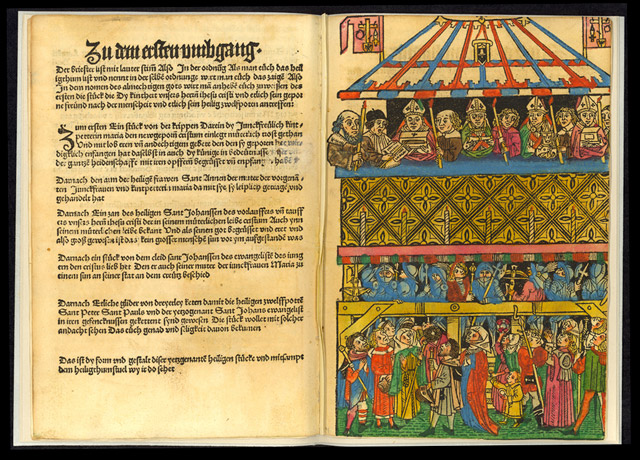Nuremberg Relic-Book
Library of Congress, Washington, DC, Rare Book and Special Collections Division

 Select the image to zoom
Select the image to zoom
With the introduction of movable type in Europe during the second half of the fifteenth century, a new kind of devotional object emerged: the Heiltumsbuch, or relic-book. Pilgrims' accounts report that relic-books could be purchased at the annual display of relics, or Heiltumsweisung, which became a regular feature of the church calendar in the fourteenth century. This suggests that relic-books served as mementos for those who traveled great distances to view the remains of a particular saint and as advertisements for those who had yet to make the journey. Relic-books were also powerful aids to devotion, offering the believer a carefully orchestrated program for venerating the saints through text and image. The practice of extending the indulgences associated with many relics to images of those relics and their containers further accounts for the popularity of relic-books.
Prepared under the direction of the Nuremberg sculptor Peter Vischer, the Nuremberg relic-book is the first of its kind. Printed on parchment, it contains six folios, including three hand-colored woodblocks, one of which shows the Heiltumsstuhl. This was a temporary wooden platform erected in the central square of Nuremberg each year for the purpose of displaying the city's most important relics. These relics included the Holy Lance, pieces of the True Cross, and the imperial insignia of Charlemagne (r. 768–814), the first Holy Roman Emperor. The phalanx of soldiers that separates the crowd gathered below from the relics held in precious reliquaries presented by local clerics and city elders in the upper register of the platform provides some idea of how carefully these objects were guarded. While somewhat exaggerated by the designer of the woodblock, the distance between the pilgrims and the relics underscores the extent to which relic-books provided a more intimate access to the remains of saints than what one experienced in ceremonies like the Heiltumsweisung.




